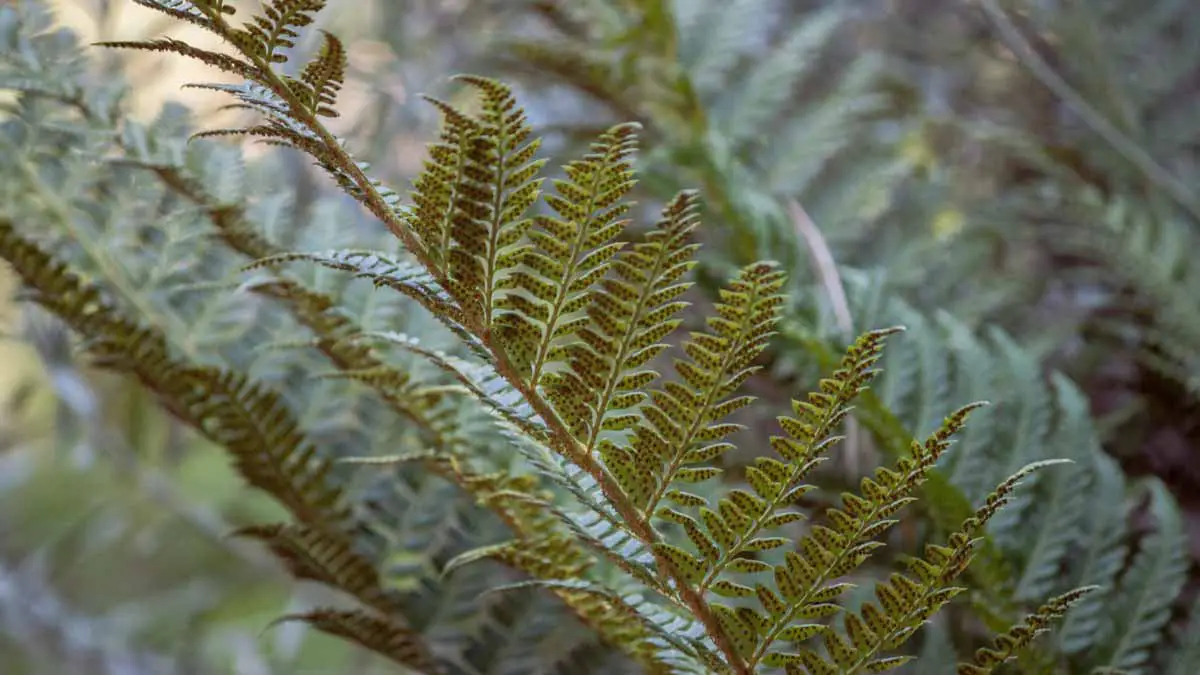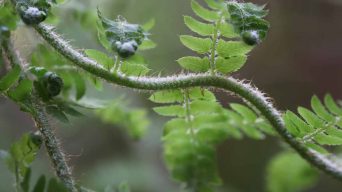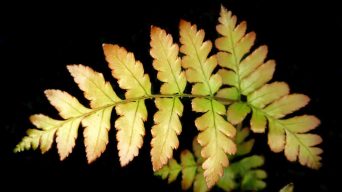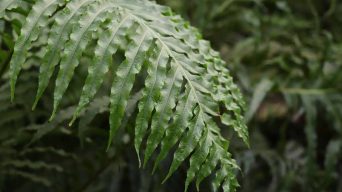Ferns are beautiful tropical plants that add a touch of elegance to any home.
They are easy to care for and add to any indoor or outdoor space.
However, fern leaves can sometimes turn black, which can be alarming for any plant owner.
Why Your Fern Turns Black and How to Fix It
There are several reasons why this may happen, but don’t worry!
In most cases, it is not severe and can be fixed with extra care.
Here are the most common causes of blackening leaves on ferns and how to fix them.
1. Overwatering
Overwatering is a common problem for fern growers.
While ferns need consistent moisture to thrive, too much water can cause the leaves to turn black and drop off.
The main reason is that overwatering encourages the growth of fungal diseases, which can quickly overwhelm the plant.
In addition, wet conditions make it difficult for the plant to breathe and cause the roots to rot.
An overwatered fern will have wilted, yellow, or black fronds.
The soil will be soggy and may even smell bad.
How To Fix It
If you think your fern plant is overwatered, the first thing you should do is stop watering it for a while.
Let the soil dry out completely before watering again.
If the leaves are still black, you may need to repot the fern in a fresh, well-draining potting soil mix.
You need to be careful not to overwater your fern in the future, so make sure you allow the soil to dry out between waterings.
2. Pest Infestation
Pests can also be responsible for black leaves on plants.
Aphids, mealybugs, and spider mites are common pests that can attack ferns.
Aphids and mealybugs will suck the sap from the leaves, causing them to turn black.
Spider mites can also cause black spots on the leaves as they feed.
You can tell if your fern has a pest infestation if you see small insects or webs on the leaves.
The leaves may also look sticky or have black, sooty mold growing on them.
How To Fix It
If you think your fern has a pest infestation, you should first isolate it from other plants.
This will prevent the pests from spreading.
Then, look at the leaves and see if you can spot any insects or webs.
If you see pests, you can try to remove them by hand.
You can also use a spray bottle to mist the leaves with water, which will dislodge the pests.
If the infestation is severe, you can treat your fern with neem oil or an insecticidal soap.
3. Low Humidity
Ferns are tropical plants, so they need high humidity to thrive.
If the air is too dry, the leaves can turn black.
This is because the plant is not getting enough moisture, and the leaves are drying out.
A fern suffering from low humidity will also have brown leaves and dry, crispy fronds.
How To Fix It
If you think your fern is not getting enough humidity, you can try misting the leaves with water.
You can also place the pot on a tray of pebbles and water, which will help raise the humidity around the plant.
Another option is to use a humidifier, adding moisture to the air and helping your fern thrive.
4. Too Much Sunlight
Fern plants need indirect sunlight to grow, but too much sun can cause the leaves to turn black.
This is because the leaves are getting sunburned.
Sunburned leaves will be black and dry and may also have brown or yellow patches.
The leaves may also start to curl and look crispy.
How To Fix It
If you think your fern is getting too much direct sun, the best thing to do is move it to a shadier spot.
Indoor fern plants should be placed in an east-facing window, where they will get indirect sunlight.
Outdoor ferns should be grown in dappled shade, protecting them from the hot midday sun.
You can also try to create shade for your fern by covering it with a sheer curtain or placing it under a tree.
5. Temperature Stress
Ferns prefer warm, humid conditions so that they can be sensitive to changes in temperature.
The best temperature for ferns is between 60 and 80 degrees Fahrenheit.
The plant can suffer from heat stress if the temperature gets too hot.
It will start to lose moisture, and the leaves will start wilting and turning black.
If the temperature gets too cold, the plant can go into shock.
This will cause the leaves to turn black and drop off.
Sudden temperature changes can also cause leaves to turn black.
How To Fix It
If you think your fern is suffering from temperature stress, the best thing to do is move it to a more suitable location.
Indoor ferns should be kept in a spot that is out of direct sunlight and away from drafts.
Outdoor ferns should be protected from the cold by being placed in a sheltered spot.
If you live in a cold climate, you can bring your fern indoors when the temperature drops.
6. Water Quality
Ferns are sensitive to water quality, so they can be affected by chemicals and minerals.
If the water is too hard, it can cause the leaves to turn black.
This is because the plant cannot absorb all the nutrients it needs.
The leaves may also start to wilt and turn brown.
If the water is too soft, it can also cause fern problems.
This is because the plant will not be able to get enough of the nutrients it needs.
Leaves may turn yellow or black and start to wilt.
How To Fix It
If you think your fern is not getting the correct type of water, you can try using filtered or distilled water.
You can also let tap water sit for 24 hours before using it, allowing the chemicals to dissipate.
Rainwater is also a good option for watering plants, as it is free of chemicals and minerals.
7. Fungal Infections
Ferns can be susceptible to fungal diseases, which can cause the leaves to turn black.
One of the most common diseases is black spot, which is caused by fungus.
This fungus will cause black spots on the leaves, eventually leading to leaf loss.
Other symptoms of black spots include yellowing leaves and stunted growth.
Another fungal disease that can affect plants is anthracnose.
A different type of fungus causes this disease, and it will cause black spots to form on the leaves.
The leaves may also start to wilt and drop off.
How To Fix It
If you think your fern has a fungal disease, the best thing to do is to remove any affected leaves.
This will help to prevent the infection from spreading.
You can also try to treat the plant with a fungicide, but make sure to follow the instructions carefully.
The best way to prevent fungal diseases is to ensure your fern gets enough airflow and is not too wet.
Place the plant in a spot with good airflow and ensure the pot has drainage holes to allow excess water to drain out.
Water the plant when the soil is dry, and avoid getting water on the leaves.
8. Bacterial Diseases
Bacterial diseases can also affect ferns, which can cause the leaves to turn black.
One of the most common diseases is bacterial leaf spot, which is caused by a type of bacteria.
This bacteria will cause brown or black spots on the leaves, eventually leading to leaf loss.
Other symptoms of bacterial leaf spot include yellowing leaves and stunted growth.
Another bacterial disease that can affect plants is bacteria blight.
This disease is characterized by black or brown spots on the leaves, leaf loss, and stunted growth.
How To Fix It
The best way to prevent bacterial diseases is to water your ferns at the base of the plant rather than from above.
This will help prevent water from splashing onto the leaves and spreading the bacteria.
In addition, you should make sure that your plants are getting enough air circulation.
Plants too closely spaced together are more likely to develop bacterial diseases.
If your fern already shows signs of a bacterial disease, you can try treating it with a copper-based fungicide.
You should also make sure to remove any affected leaves from the plant.
9. Foliar Nematode
The Pratylenchus nematode is a microscopic, plant-parasitic roundworm that causes black spots on the leaves.
The nematodes eat the plant’s cells, causing dead tissue in the form of black spots.
The damage from this nematode species can significantly weaken the plant and, in extreme cases, even kill it.
In addition to causing black spots on leaves, foliar nematodes can also cause stunted growth, yellowing of leaves, and leaf drop.
How To Fix It
Unfortunately, once your fern is infected with foliar nematodes, there is no effective way to eliminate them.
The best action is to remove and destroy any infected leaves (do not compost them).
You can also try treating your fern with an insecticide containing neem oil, which may help control the population of nematodes.
Prevention is the best method of dealing with foliar nematodes.
Clean up any fallen leaves or debris around the plant to prevent them from infecting your fern.
In addition, you should avoid overwatering your fern, as this can create an environment favorable for nematodes.
10. Root Rot
A blackened fern leaf is a telltale sign of root rot, a severe plant disease that can quickly kill even the hardiest plants.
Root rot is caused by various fungi that thrive in wet, oxygen-deficient soils.
When these fungi attack the roots of a fern, they begin to break down the tissues, causing the roots to turn black and soft.
The disease then spreads to the leaves, causing them to turn black and drop off.
In severe cases, the entire plant may be killed.
How To Fix It
Preventing fern root rot is the most effective approach to address this issue proactively.
Ensure your fern has well-draining soil and you are not overwatering it.
In addition, make sure the pot has drainage holes to allow excess water to drain out.
You must act quickly if your fern already shows signs of root rot.
First, remove the plant from the pot and inspect the roots.
You will need to cut them off if they are blackened and mushy.
Next, replant the fern in fresh, well-draining soil and water it sparingly.
You can also try treating the plant with a fungicide to help prevent the spread of the disease.
11. Fern Spores

Black spots under leaves can also be fern spores.
Ferns are a type of plant that reproduces using spores instead of seeds.
The spores, typically brown or black, are produced on the underside of the fern fronds.
When the spores mature, they are released into the air and can be carried long distances by the wind.
If the spores land in a suitable location, they will germinate and produce new fern plants.
Fern spores are not harmful to humans or animals and are quite interesting to look at under a microscope.
They can, however, be a nuisance if you are trying to grow ferns indoors.
How To Fix It
If you find black spots on the fern’s leaves that you think might be spores, the best way to deal with them is to wipe them off with a damp cloth.
You can also try using a soft brush to remove them.
Once the spores are removed, they cannot germinate and produce new fern plants.
Preventing Black Spots on Fern’s Leaves
The best way to prevent ferns from turning black is to provide the plant with the proper care.
There are several things you can do to make sure your fern stays healthy:
- Provide the plant with adequate humidity. Ferns thrive in humid environments. If the air in your home is dry, consider placing the plant on a pebble tray or grouping it with other plants.
- Make sure the plant is getting enough light. Ferns prefer indirect light but can tolerate some direct sunlight. But too much sun can cause the leaves to turn brown and black.
- Water the plant regularly. Ferns like to be moist but not soggy. Allow the top inch of soil to dry out before watering again.
- Use well-draining soil. Ferns don’t like to sit in waterlogged soil. Use a potting mix that drains well, and add extra perlite or coarse sand if needed.
- Keep the temperature consistent. Ferns prefer cool temperatures and will not do well in hot, dry climates. Avoid placing the plant near drafts or vents.
- Fertilize monthly during the growing season. Use a balanced fertilizer diluted to half-strength.
- Watch for pests and diseases. Inspect the plant regularly for signs of pests or disease. If you see anything, immediately prevent the problem from spreading.
Final Thoughts
Fern plants are generally very resilient and can withstand various temperatures and conditions.
However, even the hardiest fern can succumb to problems from time to time.
If you notice your fern turning black, quickly saving the plant is essential.
Most of the time, you can save your fern by taking corrective action and addressing the underlying problem.
Sometimes, the damage may be too severe, and you may need to start with a new plant.
If you think your fern might be suffering from any of the abovementioned issues, look closely at the plant and try to identify the problem.
Once you know what’s causing the black leaves, you can take steps to fix the issue and get your fern looking healthy again.







